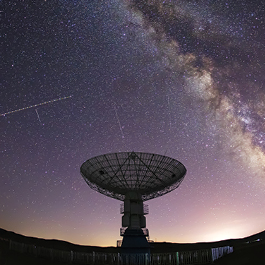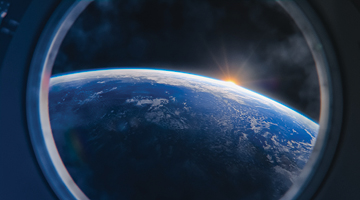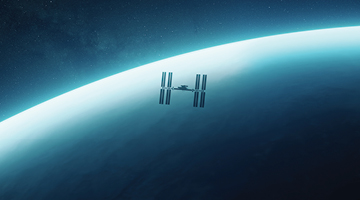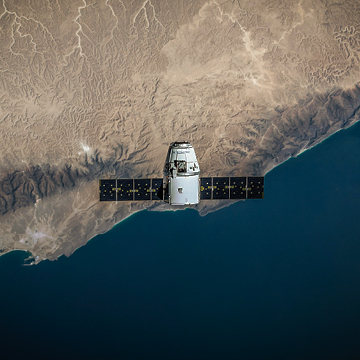The Next Frontier
As the world looks to advancements being made by space futurists, Pepperdine alumni explore the evolving landscape of the space economy
More than five decades have passed since Neil Armstrong's voice crackled over television sets and radios across the United States announcing the Apollo 11 mission had successfully landed man on the moon. "That's one small step for man, one giant leap for mankind," Armstrong said before planting an American flag in the moon's rocky terrain. The phrase is often the first thing that comes to mind at the mention of space, along with, perhaps, William Shatner's iconic introduction to the science fiction favorite Star Trek, "Space: the final frontier." These two perceptions of space exploration have rendered the topic to moments in history and tales of fiction, even as the US took first place in the space race of the 1950s and '60s and established itself as a leader in lunar missions.
In recent years, space exploration has returned to the front page of the news cycle as billionaires Elon Musk, Jeff Bezos, and Richard Branson launched orbital or suborbital vehicles into the atmosphere and set in motion the public's interest in private spaceflights. While space exploration became a trending topic almost overnight, industry insiders have, for years, been involved in the critical work being done behind the scenes that have launched those headlines into the hands of fascinated and mystified readers.
Behind the Headlines

A radio telescope and the Milky Way
Following the declaration of the end of the Cold War, America refocused on regional counterterrorism that Gregory Pejic (MPP '06), former deputy assistant secretary of defense for space policy at the US Department of Defense, says may have leveled the playing field for global advancements in space. "While those conflicts distracted us," he says, "China and Russia were making investments to catch up with America's more advanced technical capabilities and took steps to militarize space."
During the end of the century, US researchers focused on collaborations at the International Space Station and other non-human, artificial space exploration technology, such as the launch of the Mars rovers and other satellites orbiting Earth's planetary neighbors. With the retirement of the space shuttle program in 2011, human space flight slipped further back in Americans' minds. The concept of space tourism remained in the realm of science fiction.
However, for the last 20 years, Musk's SpaceX, Bezos' Blue Origin, and Branson's Virgin Galactic have been working behind the scenes to develop, test, and innovate rockets and technologies with strong support from public entities including the National Aeronautics and Space Administration (NASA). While a fascinated public watched as the founders tested their respective products firsthand, hundreds of engineers, scientists, and technology innovators were also working tirelessly to propel their out-of-this-world innovations into the future.
Inventors have begun drafting proposals for robotic technologies to explore lunar craters and mine rare materials from asteroids. Scientists observing space weather and Earth's neighbors have gained a better understanding of potential climate disasters at home. Astronomers have expanded our understanding of deep space, looking into neighboring galaxies, black holes, and supernovas.
In 2022 even more progress will be made as engineers and scientists continue critical missions to comprehend the cosmos. Another rover will make its way to Mars and begin to study deep subsurface soil for the first time. The rover will continue to uncover the possibilities for human habitation on Mars.
By 2024 Axiom Space will send the first module of the first commercial space station to the International Space Station, allowing private industries to test out new technologies and research even more innovation alongside projects underway there. The Axiom commercial station, with its cushioned sleeping pods and sophisticated manufacturing and research facilities, is thought to be the next step toward a thriving low- Earth orbit economy filled with tourists and researchers alike.
Here on Earth

It's a common misconception that space doesn't impact our life on Earth, but with our dependence on communications, GPS, and weather monitoring, space impacts our daily life much more than we think.
—Gregory Pejic (MPP '06)
Despite these exciting developments, the average American might still be challenged to understand the benefits of space exploration. Society continues to grapple with climate change, rising poverty and homelessness rates, and, since 2020, the COVID-19 pandemic. In a 2019 survey from the Pew Research Center, a majority of Americans viewed human space travel as less important than routine climate and asteroid monitoring. The common critique as Musk, Bezos, and Branson each made their highly publicized journeys to space was, "Why does this matter?"
"That is sort of the question, right?" asks Pejic. "It's a common misconception that space doesn't impact our life on Earth, but with our dependence on communications, GPS, and weather monitoring, space impacts our daily life much more than we think."
When advances are made in space technology, they are not only applicable to space solutions but can more often than not be applied to terrestrial life and solve pressing problems on Earth. GPS systems and satellite imaging services have been used to help farmers assess crops. Additionally, radar technology, developed to track seismic shifts or gravity fluctuations on planets, have been adapted to identify slight movements underneath dense rubble following natural disasters.
On Earth humans must meet several needs every day in order to survive— clean air, nutritious food, and drinkable water. To meet these needs in space seems so daunting that it's difficult for average Americans to justify the cost. Experts believe that if we can learn to survive in space, the solution to the terrestrial-based problems becomes closer than ever. For example, NASA's efforts to cultivate produce in controlled environments like the International Space Station unlocked a pathway for farmers to build two-acre indoor vertical farms that sustainably produce the same yield as a farm hundreds of acres larger.
Material used for insulation to keep fuel reserves cool or to keep astronauts comfortable inside their hefty space suits has been adapted to create insulated blankets and clothing to withstand subzero temperatures on Earth and to keep racecar drivers cool as they speed hundreds of miles per hour around the racetrack. These are just a few of the thousands of technological projects that have improved terrestrial life due to their success in space.

"In the last two years, we have seen advancements in technology that we did not see for the last 20 years," says Pratish Shah (MBA '10), general manager of the United States operations of leading satellite solutions manufacturer Aitech. "The reason for this shift is the onslaught of the commercialization of space."
One challenge that new developments can only curtail in part is the need for a clear analysis of a project's feasibility and utility. Private businesses must assess a part's profitability long before they send it through the development processes. This allows for companies to pursue promising endeavors, provide an exceptional advancement to the landscape, and produce advanced materials in higher quantities at reduced costs.
"I don't want to build one component for one satellite," says Shah. "I want to build components for thousands of satellites. That drives me to have business-scaling in mind while making products that are safer and more ubiquitous."
Aitech is making critical strides in the space technology landscape. The company's supercomputers are designed to bring advanced computing capabilities to satellites with a fraction of the weight of earlier models while withstanding space's high radiation levels. Its space-safe solid-state storage hard drives boast terabytes of storage, opening up the opportunity for a space-based data center to house the massive amount of digital data humans create on a daily basis. The company is also exploring how to improve network capabilities in space hubs such as the International Space Station as promises of interplanetary tourism require the availability of Earth- based conveniences far away from the planet.
"The technology and the innovation is outpacing the customer demand," says Shah. "But as more and more progress is made and businesses keep up this competition, these costs will be reduced, which opens space travel opportunities for the average person, just like we saw with aviation and air travel."
Reaching for the Stars
![]()
In 2019 NASA partnered with private businesses to explore 3D-PRINTING TECHNOLOGY to manufacture and assemble materials in space, potentially reducing launch and technology.
![]()
In 2020 SpaceX transported NASA astronauts to the International Space Station, becoming
the FIRST PRIVATE COMPANY to do so and removing NASA's dependence on Russian spacecraft to transport astronauts.
![]()
In partnership with NASA, American 3D-printing architecture company ICON will put
SPACE INHABITANCE to the test in 2022 with a terrestrial-controlled simulation in a carefully crafted
facility in the Mars-like Texas desert.
![]()
The Jupiter Icy Moons Explorer, abbreviated as JUICE, will launch later this year
to begin its nine- year JOURNEY TO JUPITER’S ORBIT to study the possibility of life on the planet's moons.
![]()
By 2024 NASA's Artemis program, fueled by innovative technology from private companies
across the nation, will send the FIRST WOMAN and FIRST PERSON OF COLOR TO THE MOON.
Pushing the Legal Envelope
As with maritime law developed following the advancements of nautical travel and aviation regulations established years after the Wright brothers' first flight in 1903, lawyers and policy makers are also pondering the nuances of international space law.
"As the science and technology continues to expand, we are going see a lot of rethinking and reframing of some of our international space laws that are currently in place," says Brian Link (JD '10), assistant professor of teaching of business law at Seaver College.
Since 1967, the space environment may be used only for peaceful purposes and, according to the Declaration of Legal Principles Governing the Activities of States in the Exploration and Use of Outer Space adopted in 1963, the United Nations declared that celestial bodies, which refers to any non-synthetic object in space, whether planet or asteroid, cannot be appropriated by any nation. However, with science pushing toward Mars inhabitance and the potential of precious mineral mining, these existing laws become even more complicated.

Brian Link (JD '10)
"These new technologies push our existing legal frameworks to consider questions we've never posed before, like ‘Who can own the moon?'" says Link. "If a tourist books a flight to space and there is an accident, who is liable for that accident? Does the tourist assume the risk or is the private company responsible?"
The hypotheticals are seemingly never-ending. In the case of rare mineral extraction from asteroids, how does a nation claim and mine those resources if an asteroid cannot be appropriated by a national power? The question becomes more nuanced if the resources land in the waters or on the soil of another nation on their return back to Earth.
Skilled people from all sectors must contribute to the development of laws to address these questions, assess risk, and lay a foundation for acceptable behavior in space. Within the next decade, Link anticipates significant changes to international space law to make room for such groundbreaking technological advances. With increased interest and traffic and the very real potential of space tourism in the near future, safety is crucial for the space economy to continue on its course.
"I think it can be easy for us to take for granted our own safety at home and in space because of America's global standing," shares Pejic. "But should conflict arise in space, it has the potential of disrupting our daily life in big ways. We need to work with allies and partners to establish norms of behavior for operating in space, and we need to do everything possible to protect our vulnerable space assets."
Risk Assessment

A view of Earth as seen from the International Space Station porthole
In November 2021, Russia tested an anti-satellite weapon system and destroyed one of its own inactive satellites. The immediate concern was the resulting debris cloud that cluttered low-Earth orbit and jeopardized the safety of other satellites, the International Space Station, and each of the astronauts on board. While the debris did not result in further harm, it put international powers, especially the US, on edge and shed light on the precarious state of the space economy if safety and defense are not top priorities.
"We saw with President Trump's announcement of the creation of the Space Force in 2019 how space defense was a bit of a laughable topic for many people," shares Jeremy Grunert (JD '13, MPP '13)*, US Air Force major, judge advocate officer, and assistant professor of space law at the United States Air Force Academy. "But if we explain to people just how dependent the United States is on space technology such as GPS, which is integrated into our financial and shipping systems and on which first responders rely to provide needed services, the concept of an organization that protects those things makes a lot of sense."

The International Space Station in orbit above Earth
Prior to the United States' creation of the Space Force and the acknowledgment of outer space as a war-fighting domain, international competitors had already recognized the importance of safety for space and its impact on national security and cybersecurity. For example, in 2015 China launched the Strategic Support Force branch of the China People's Liberation Army, which focused on protecting space and cyberspace. As more nations developed anti-satellite weapons systems, and as the global network of thousands of functioning satellites remains virtually undefended, the US jumpstarted its development of defense measures for the safety of all space users. Grunert now balances the challenges of educating people about the misconceptions and importance of space defense with the nuances of existing international space law.
"Humankind was molding the law of an entirely new physical domain before we could even do certain physical things in outer space," says Grunert. "Eisenhower's and Kennedy's administrations worked to balance US security concerns and the development of international law in outer space, and the US settled on a ‘nonaggressive' interpretation of what it means to use outer space for ‘peaceful purposes.' This concept, combined with later binding space law prohibiting nuclear weapons and weapons of mass destruction in outer space, is actually very permissive from a military perspective and allows a wide range of military and dual-use space systems."
Some of that dual-use equipment could be photo surveillance satellites currently used to monitor farmland, forests, or other environmental conditions adapted to become photo reconnaissance technology if the need arose. As these technologies are used for so many critical Earth-based functions, the importance of their safety is multiplied.

The SpaceX Dragon cargo spacecraft cruising over the coast
Private companies are also evaluating safety risks when determining their foray(s) into space exploration. If mining equipment were to disrupt an asteroid's orbit even slightly, thousands of satellites in low-Earth orbit would be at risk and, in a worst-case scenario, Earth itself could be compromised. Questions about how to protect and prevent these events from occurring remain.
"Assessing all of the risk is really only possible with strong international and public and private collaborations," says Pejic. "We'll need all of these players to continue setting standard rules and norms of behavior as activity in space becomes more and more commonplace."
Like Link, Grunert believes adjustments will likely be made to international space law within the next decade to give both those in business and government more peace of mind in their space expeditions. Additionally, with the introduction of space tourism in the very near future, consumers and providers will need to be assured of safety. Even in the midst of these challenges and incalculable unknowns, Grunert sees a new generation of talent quickly emerging that is both passionate and motivated about the possibilities in outer space. With more space-trained talent, Shah believes innovations in technology will continue to go to places formerly thought of as impossible.
"We are dealing with a 20- to 30-year gap in space interest and skilled space personnel, many of whom are now retiring," says Shah. "Now as interest expands particularly in these last few years, new talent that is able to respond to requests from space commercialization businesses with realistic technical solutions will enter the industry and push the technology even further—so much so that we could see space tourism become more accessible to the average person in about 10 years."
*Views expressed do not reflect the official policy or position of the US Air Force Academy, the Air Force, the Department of Defense, or the US government.
